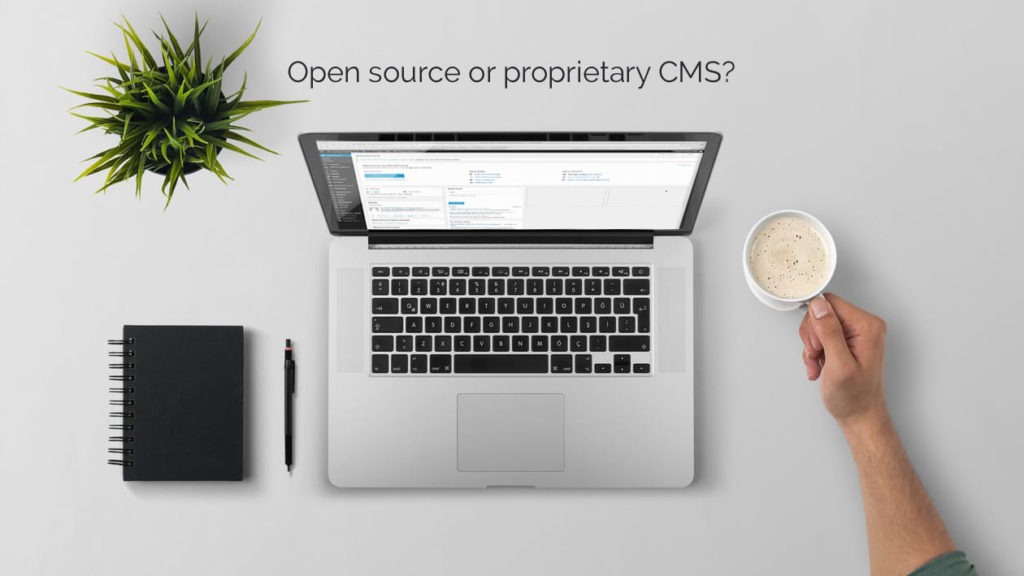Should you opt for an open source or proprietary CMS for your business website?

Your website needs to meet many needs. The marketing department wants it to be a source of engaging and informative content so that it leads prospective customers through the buying process. The IT department wants it to be easy to maintain and update, and not be susceptible to hacking or security threats. And the chief exec is keen that the investment breaks even, or better still, brings in additional income.
There are many website content management systems that will do all these things. But which one should you choose? Perhaps the first decision to make is to choose whether you opt for an open source or proprietary CMS.

Open source or proprietary CMS: what are the differences?
Open source systems are those such as WordPress, Drupal, Joomla and DotNetNuke. They are free and are developed in a voluntary capacity by interested parties worldwide. The software is not owned by a company or a body, but is available to all.
Proprietary systems are built and managed by a single company. They don’t typically allow their buyers access to the source code, but sometimes provide an application programming interface (API) so that other systems can easily interact with them. They may also have to be hosted by the software supplier.
To help decide whether to use open source or proprietary CMS, let’s compare the two options across a number of aspects.
Initial cost
With open source, the software itself is free. But you will obviously want someone to enhance and develop it to give you the all the functionality you’re looking for and to give it a unique design that reflects your corporate branding.
With proprietary CMS, pricing varies. It can sometimes be expensive because the in-house resource needed to maintain a robust development approach is considerable. But equally, where a CMS has taken off within an industry, development costs are spread further and so there can often be less expensive options available. For example, there are CMS packages for car dealerships and for recruitment consultancies that you can buy for less than a thousand pounds a year.
Ongoing costs
With a proprietary CMS, when it comes to maintaining and updating your site after it’s gone live, you will probably enter into a monthly or annual license fee agreement. You don’t own the software, but lease it from the vendor.
Open source CMS also have ongoing costs, as there will be frequent updates to the source software and to any add-ons that you have. A development company can do this sort of ongoing maintenance for you. Or, like many enterprise users, you may have the necessary skills within your IT team.
Future flexibility
With proprietary software, you are very much tied to that system and so have to use your provider for any changes. Some see it as being handcuffed to a technology as it can be difficult or even impossible to export your content and data out of the system if you later want to migrate to a different CMS. You will almost certainly not be permitted to edit the source code, so won’t be able to use a different agency for your site. This may present an issue if you become dissatisfied with the customer support you’re receiving, or if the company you’re using gets into financial difficulties.
With open source CMS, not only is the source code freely available, but you can also export your data and content when you want. This effectively allows you to remain platform-neutral and to easily switch to another CMS down the line if you want. The very fact that the software is open source has contributed to the massive growth of these systems. In turn, this means that there are hundreds of developers that are fluent in using these systems and so you will always be able to find someone suitable to work on your site if needed.
Supplier ownership
Open source CMS is not owned by a company and so there is no ultimate responsibility if something goes wrong with the software. There’s no-one you can turn to and say, “This isn’t working, fix it”. However, as there are so many developers of these systems, issues are typically resolved speedily. And larger companies tend not to be confronted with the problems as they typically work with a technology partner that will manage those aspects for them.
With proprietary systems, it’s important that you feel confident about the company behind your chosen package. You want to choose one that can continue to invest both money and development time in the CMS technology to enhance it so that it remains competitive with other systems.
Security
It’s an unhappy truth that the larger something becomes, the more likely it is to be targeted by the unscrupulous and greedy. So, sites built on these popular open source platforms are more susceptible to malicious attacks and spamming. However, as these platforms are used by thousands of developers, it’s common for a bug or security issue to be quickly spotted. Open source providers are great at continually upgrading their software. Updates and security patches are actively pushed out to users, who can decide if they want to upgrade or not.
With a proprietary CMS, there may fewer companies using that system and so you need to carefully evaluate the company behind the package. You will want to choose one that is up to date with security issues and which invests in assessing and addressing security threats.
Vertical market specialisation
When choosing open source or proprietary CMS, consider what it is that you want your software to do. If it is very specialised or requires niche functionality, then sometimes proprietary software will best meet those needs.
The most successful proprietary CMS platforms are those that have been built specially to fit the needs of a certain industry. For example, many independent schools use a system to manage and display their sporting fixtures, news and team sheets. It is a “best-of-breed” platform that successfully meets the needs of that sector. If there’s already a great CMS in your own niche, you need to weigh up whether it’s worth starting again and having a company build the functionality you need from scratch, or whether to go with the successful and already-proven proprietary CMS but to accept that your website will look pretty much the same as everyone else’s.
Integration
Third-party software integrations are typically more readily achieved with open source software, again because of the large number of plugins and modules that are available for them. For example, integrating your email marketing system so that you can collect new signups from your website or capture responses to campaigns is a breeze with plugins and add-ons. There are integration options for all the major email marketing systems – such as Mailchimp, Constant Contact, AWeber and Campaign Monitor – and even for smaller, less well-known packages.
For proprietary CMS, things are varied. Many will have the capability to integrate with the very popular packages. But there is such a wide variety of software and apps for integration with websites that not all will be catered for when it comes to each and every proprietary CMS. For example, aside from email marketing, there’s software, apps and plugins for: chat and customer service, advertising and affiliate selling, forums, social networking, spam elimination, SEO, forms, social sharing, and all manner of admin-side functionality to make the user’s life easier and to help the website run better.
Of course, any integration is usually possible within a proprietary CMS, but does need an investment in time and money to complete some bespoke engineering.
Conclusion
Making the choice of an open source or proprietary CMS needs to be a thoughtful and deliberate process. Both options have a place in the current business landscape, but one will likely suit your business better than the other.
Take the time to consider the proprietary systems that exist for your industry or sector and see if they fit what you’re looking for. It may well be the case that some simple customisation and the ongoing license fees will give you exactly what you want. But if not, then an open source CMS that may cost more upfront, but which can be customised to your exact needs might be the way to go.
You may also be interested in these articles
Brexit for WooCommerce sellers
The impact of Brexit is huge. There are very many implications for those in e-commerce businesses…
Read more
Brexit for WooCommerce sellers
Cynefin: a valuable framework to classify, communicate and respond to tasks in digital projects
Cynefin. At Angry Creative we think it’s a vital part of digital projects. It helps us to underst…
Read more
Cynefin: a valuable framework to classify, communicate and respond to tasks in digital projects
Web fonts for WordPress
Fonts control how your text is displayed – how the letters actually look. web-safe fonts. W…
Read more
Web fonts for WordPress
Subscribe to our newsletter for tips, inspiration and insight about WordPress and WooCommerce and the digital world beyond.
Time to take the next step towards a more effective website?
Contact us, and we can talk more about how we can take your business to the next level together.